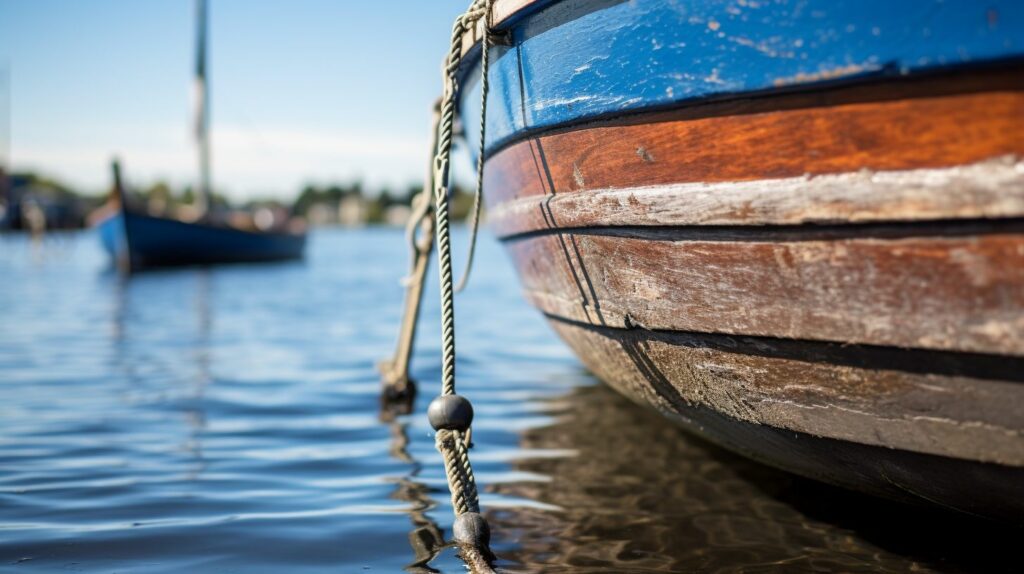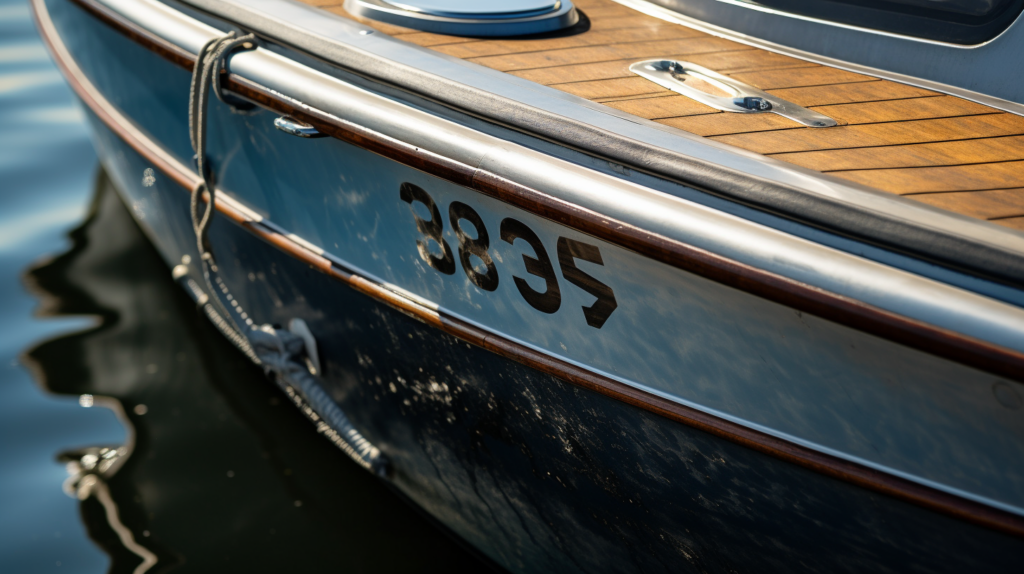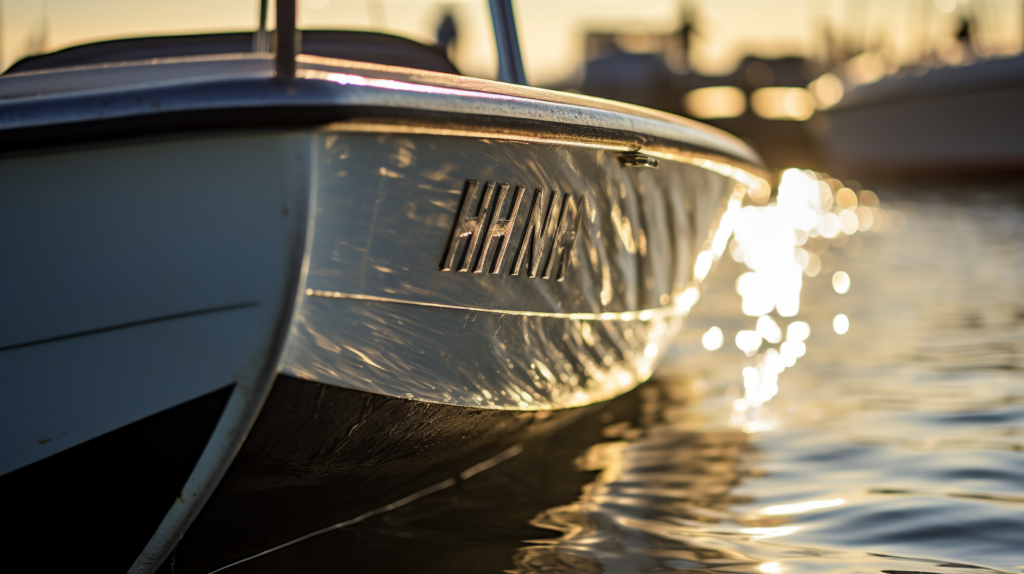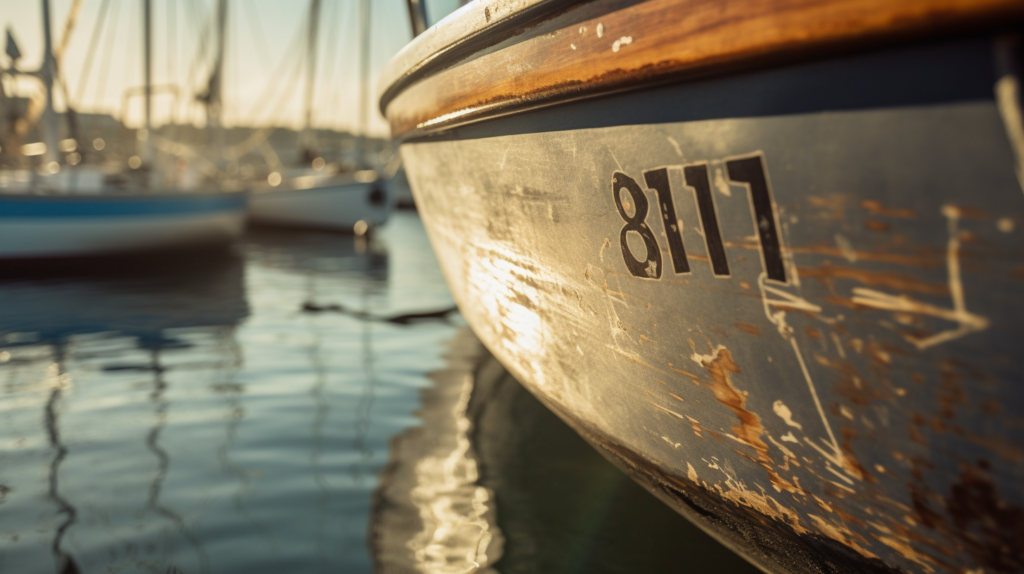Table of Contents
Table of Contents

Ever wondered what those mysterious digits on your boat’s hull mean? These characters, known as the Hull Identification Number (HIN), are a unique fingerprint for your vessel.
This article serves as a comprehensive guide to understanding and utilizing this crucial identifier, offering you invaluable insights about your craft. Ready to dive into the world of HIN? Let’s set sail!
Key Takeaways
- Hull Identification Numbers (HINs) are like fingerprints for boats. Each one is unique and tells lots of information about your boat.
- The HIN can tell you who made the boat when it was made, and its model year. It’s a 12-digit code without spaces or hyphens.
- Having a clear HIN on your hull is important for safety reasons and it helps with warranty claims too.
- You can usually find the HIN on the front right side of your boat’s stern, but there might be another one inside somewhere as well.
Understanding Hull Identification Numbers

The Hull Identification Number (HIN) is a unique serial number assigned to every boat, much like a vehicle identification number for cars. It follows a specific format combining letters and numbers in the 12-digit code.
This HIN helps in determining the boat’s model year, manufacturer’s identification code, production month, and year along with other vital information about the vessel.
What is a Hull Identification Number?
A Hull Identification Number (HIN) is a distinctive serial code assigned to each vessel by its manufacturer. Like Social Security Numbers for people or Vehicle Identification Numbers for cars, every boat has a unique HIN that sets it apart from others.
Federal regulations mandate this 12-character identification system for all vessels. The format of the HIN excludes spaces or hyphens to keep it simple. To kickstart the series of characters in an HIN, the first three are usually reserved for the manufacturer’s identification code.
Format of a HIN
A Hull Identification Number (HIN) follows a universal format for readability and identification. This unique serial number contains 12 characters, without the use of hyphens or spaces.
Starting with the Manufacturer’s Identification Code (MIC), which are the first three characters in a HIN, this provides information about who made the vessel.
Advancing to the next five characters, these display the unique serial number assigned by that manufacturer to each boat they produce. The final four characters show not only the production month and year but also the model year of the boat.
Understanding this structured sequence can offer valuable insights into your boat’s history and origin. Finally, every HIN ends with two extra digits that specify the compliance documentation date for Coast Guard regulations – meaning whether it is certified or not for water service.
Importance of Hull Identification Numbers

A Hull Identification Number (HIN) is crucial in providing information regarding the boat’s model year, an essential factor when seeking warranty services. The HIN also plays a vital role during emergencies by helping identify boats quickly and efficiently.
Moreover, it can be an invaluable tool for manufacturer recalls, vessel registration, and certificate documentation purposes.
Identifying the boat’s model years
Deciphering your boat’s model year is as simple as examining the last two digits of its Hull Identification Number (HIN). These final characters represent the model year, indicating the exact period it was manufactured.
This crucial information can greatly assist sailors when registering their vessels or seeking manufacturer recalls. Hence, understanding and utilizing this component of the HIN plays a significant role in managing essential aspects of your boat ownership journey.
Useful for warranty information
Boat manufacturers rely heavily on the Hull Identification Number (HIN) to manage warranty claims effectively. The unique series of digits and letters within the HIN, known as the manufacturer’s identification code, provides crucial data about each vessel.
This code allows them to easily track down the exact make and model of your boat when you submit a claim. Furthermore, because the production month and year are included in this number, it can help determine if a piece of equipment or component still falls under warranty coverage.
Therefore, ensuring that your HIN is visible on your boat hull could end up saving you significant costs for repairs covered by warranties. It also helps maintain integrity as manufacturers must affix this unique identifying detail in such a way that prohibits easy alteration or removal.
Assists in identifying the boat during emergencies
In the throes of a crisis at sea, every second counts. Hull Identification Numbers (HINs) become lifelines for emergency responders, enabling them to accurately locate and identify specific vessels in distress.
This rapid identification helps streamline rescue efforts and facilitates effective communication with boat owners or operators during these high-pressure operations. Furthermore, HINs also allow government agencies to swiftly trace the history of boats involved in such events, providing vital context that can aid ongoing investigations or inspections.
So not just essential for registration or documentation purposes, this unique 12-digit number assists greatly in maritime safety as well.
Where to Find Your Boat’s HIN (Hull Number)

Your boat’s Hull Identification Number (HIN) is typically located on the starboard side of the stern or transom, within one foot from the top. Additionally, a duplicate HIN may be found in an unexposed location on the interior of your vessel.
It is crucial to check both locations as this unique 12-digit number serves several vital purposes including identifying your boat model year and assisting with information during warranty processes.
Location of the Hull ID Number tag
Manufacturers typically affix the Hull ID Number tag on the upper right side of a boat’s transom. However, for vessels without a transom, you may find this unique identification number near the starboard outboard side or within one foot of the stern.
Some boats even come with a secondary HIN tucked away in an unexposed area, serving as backup identification. It is essential to note that these numbers must be permanently attached to ensure their visibility and traceability.
This could mean they are carved, burned, stamped, embossed, molded, or bonded into the hull – obvious signs will be present if anyone attempts to alter or replace them.
Other Names for HIN Number

There are several alternate terms used interchangeably with the Hull Identification Number. Each of these names carries the same meaning and serves the same purpose in identifying a boat’s manufacturer, model year, and unique serial number.
1. “Boat Hull Number“: This term is commonly used by boaters and manufacturers alike.
2. “Vessel Identification Code“: Mostly preferred when dealing with formal documentation or legal processes related to the vessel.
3. “Manufacturer’s Identification Code“: Although this mainly refers to the first part of a HIN, it is sometimes employed as an alternative name for the full HIN.
4. “Hull Serial Number“: Frequently used in referring to HIN during inspections and registrations of boats.
5. “Boat Identifier“: A generic name that underscores its function as a unique identification tool for every manufactured boat.
6. “Hull ID”: Commonly mentioned among sailors and professionals within marine industries.
Each of these terms points back to one crucial identifier—the Hull Identification Number—that assists both owners and administrative bodies in managing important matters like recalls, warranties, vessel registration, model verification, logbook references, etcetera seamlessly from manufacture to maintenance over the lifespan of any boat.
Conclusion
Hull Identification Numbers provide indispensable information for boaters and authorities alike. They serve as an essential tool in managing warranty details, facilitating rescues during emergencies, and ensuring compliance with federal regulations.
Having a clear understanding of HINs not only helps you know your boat better but also reinforces safe and responsible boating practices. Thus, the importance of Hull Identification Numbers stretches far beyond mere numbers; they are vital to safety, identification, and enjoyment on the water.
Related Articles
https://www.sailorista.com/what-are-the-parts-of-a-sailboat/
https://www.sailorista.com/what-kind-of-sailboat-hulls
FAQs
1. What is a Hull Identification Number (HIN)?
A Hull Identification Number, or HIN, is a unique 12-digit serial number assigned by the manufacturer that uniquely identifies a boat. It’s permanently affixed to the starboard side of the transom within two inches from the top of the hull side.
2. Why are HINs important for boats?
The main function of an HIN is similar to a vehicle identification number; it helps identify and track each boat manufactured since 1972. This identification code assists in vessel certificate documentation and state registration processes.
3. Where can I find my boat’s HIN?
The primary hull identification number is located on the starboard outboard side of the transom, within one foot of its top and nearest stern—the hull ID must be affixed in an unexposed location on the interior or beneath a fitting or item of hardware as well.
4. How does an HIN work in identifying my boat’s model year?
A HIN includes details like manufacturer identification code, month, date of manufacture, and model year – these details form part of your logbook for quick reference for your boat’s history.
5. Can you change or replace your Boat’s Hull ID number?
No! Alteration should not happen unless necessary because replacement would be obvious due to differences in color or texture with the surrounding hull area – which may cause suspicion about your watercraft’s authenticity!
6. Do all boats have an assigned Hull Identification Number?
All boats manufactured after November 1st, 1972 must bear their unique serial numbers known as Hull ID numbers- whether they’re new builds by manufacturers who obtain their codes, or even those refurbished before this date but completed afterward.
7. Does every boat require a Hull Identification Number?
Yes, every boat that is manufactured or imported into a country where HINs are required must have a Hull Identification Number. However, specific regulations may vary between jurisdictions.
8. Is the Hull Identification Number the same as the boat registration number?
No, the Hull Identification Number and boat registration number are different. The Hull Identification Number is a unique identifier assigned by the manufacturer, while the registration number is obtained from the relevant boating authority and is used to identify the boat when it is registered.
9. Is the Hull Identification Number permanent?
Yes, the Hull Identification Number must be permanently affixed to the boat. It should not be easily removable or transferable.
10. When should I use the Hull Identification Number?
The Hull Identification Number is typically required when registering a boat or when providing identification information to authorities. It is also used for tracking and safety purposes.
11. What information does the Hull Identification Number provide?
The Hull Identification Number provides information such as the manufacturer identification code, the date of certification, the year of certification, and the last digit of the year the boat was manufactured.
12. Can I get a duplicate Hull Identification Number?
In case you need a duplicate Hull Identification Number, you should contact the manufacturer or the appropriate boating authority for assistance with the process.
13. Is the Hull Identification Number the same as the primary HIN?
Yes, the Hull Identification Number is often referred to as the primary HIN.
14. What should I do if the Hull Identification Number is missing or illegible?
If the Hull Identification Number is missing or illegible, you should contact the manufacturer or the relevant boating authority to determine the appropriate course of action. In some cases, they may provide guidance on how to obtain a replacement or how to address the issue.

